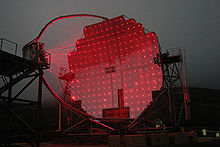MAGIC telescopes
The two MAGIC telescopes ( M ajor A tmospheric G amma-Ray I maging C herenkov Telescopes ) are the world's largest aerial Cherenkov telescopes . You are standing on the Roque de los Muchachos at an altitude of over 2200 m on the Canary Island of La Palma .
As part of the Roque de los Muchachos observatory, there are a number of other telescopes in its vicinity, including the previous experiment HEGRA . The first MAGIC telescope (now MAGIC I) was put into operation in 2004. The sister telescope MAGIC II has been working in the immediate vicinity since 2009.
Working method
MAGIC's instruments are able to indirectly observe cosmic gamma rays in the range between 30 GeV and 30 TeV. This closes the gap between the large earth-based gamma telescopes (detection range above 300 GeV) and the satellites, which are used to detect gamma radiation between a few keV and a few GeV. Gamma radiation in this area is usually emitted by rotating black holes and neutron stars . The observation of the particles of dark matter is also possible here.
MAGIC detects the so-called Cherenkov light in the shower of particles in the atmosphere triggered by cosmic gamma particles . On the basis of the different shapes of these Cherenkov flashes of only a few milliseconds in duration, gamma particles and other triggering particles can be distinguished. The cameras from MAGIC are able to detect individual Cherenkov light quanta .
aims
The MAGIC project is mandated to examine a number of objectives:
- active galactic nuclei (AGN, Active Galactic Nuclei)
- Supernova remnants
- various unidentified sources with lower energy
- Bursts (Gamma Ray Bursts)
Technical specifications
Most of the instruments used were not available some time ago and some have been specially developed for MAGIC. In particular, detection methods are also used which so far have mainly been used in particle accelerator experiments. This relates to particularly powerful network components, computers, electronics and data processing that are required to process the sometimes very large amounts of data.
Key figures for the MAGIC telescope
- Active mirror surface 239 m², consisting of 50 cm × 50 cm aluminum mirrors
- light and stable frame made of carbon fiber reinforced plastic
- Detector with a diameter of 1.05 m
- The detector is suspended with thin cables and in an aluminum frame
- Data is transmitted from the detector via fiber optics
- Detector as light as possible, only contains amplifier and laser control
- Digitization takes place with an AD converter with a sampling rate of 2 GHz
- Mass of the entire telescope approx. 40 t
- 20 seconds response time with which the telescope can be aimed at any point in the sky
detector
The detector consists of a circular area with 396 individual 1-inch photomultipliers in the center, each 18 mm in diameter, which are then surrounded by 180 1.5-inch photomultipliers.
Improvement through MAGIC II
Another Cherenkov telescope (MAGIC II) was erected at a distance of 85 m from the MAGIC telescope by June 2009. It is identical to MAGIC I except for the aluminum reflectors. These have a side length of 1 m and therefore have four times the area. The aim of this extension is to improve the low photon yield of low- energy showers. The parallel observation of air showers with both telescopes improves the detection limit of Cherenkov flashes by a factor of 3, which means that weaker gamma sources can also be detected.
Note: The two telescopes MAGIC I and MAGIC II are dedicated to the German astrophysicist Florian Goebel , who lost his life in a tragic accident on September 10, 2008 while working on the MAGIC II telescope.
Members of the collaboration
Various institutes and groups work together on the MAGIC telescope project:
- Instituto de Astrofisica de Andalucia, Granada
- Institut de Física d'Altes Energies, Barcelona
- Autonomous University of Barcelona
- CERN, Geneva
- Instituto de Astrofisica de Canarias
- INAF - National Institute for Astrophysics, Rome
- Croatian MAGIC consortium, Zagreb
- German Electron Synchrotron ( DESY ) Zeuthen
- Technical university Dortmund
- Institut de Ciencies de l'Espai (IEEC-CSIC), Bellaterra , Spain
- Division of Experimental Physics, University of Lodz
- Complutense University of Madrid , Madrid
- ETHZ, Zurich
- UNIGE, Geneva
- Dipartimento di Fisica, University of Padua and INFN sez. di Padova, Italy
- Dipartimento di Fisica, University of Siena and INFN sez. di Pisa, Italy
- Institute for Nuclear Research and Nuclear Energy, Sofia
- Tuorla Observatory , Pikkiö , Finland
- Dipartimento di Fisica - University of Udine and INFN Trieste, Italy
- University of Würzburg
- Institute for Particle Physics, Swiss Federal Institute of Technology, Zurich
Web links
- MAGIC collaboration
- Alessandro de Angelis, Luigi Peruzzo: The MAGIC Gamma-Ray Telescope, Stars and Space, August 2007
Individual evidence
- ↑ hamamatsu.com: What is a Hybrid Photodetector? ( Memento of the original from July 2, 2016 in the Internet Archive ) Info: The archive link was automatically inserted and has not yet been checked. Please check the original and archive link according to the instructions and then remove this notice.
- ↑ MAGIC Telescopes homepage: MAGIC> Florian Goebel ( Memento of the original from September 13, 2018 in the Internet Archive ) Info: The archive link was inserted automatically and has not yet been checked. Please check the original and archive link according to the instructions and then remove this notice.
Coordinates: 28 ° 45 ′ 43 " N , 17 ° 53 ′ 24" W.



